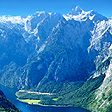MITTENWALD – BAVARIAN ALPS
Picturesque Alpine Village of Violins
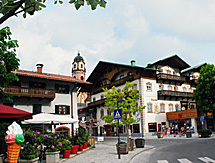 Mittenwald is one of the prettiest villages of the Bavarian Alps, lying in a mountain cloaked valley at the edge of the Austrian border on the road between Munich and Innsbruck. Johann Goethe called Mittenwald, “a living picture book”. The famous author of Dr. Faustus came to the town in 1786, then already famous itself for it violins, while on his route to Italy, and the town, which straddles the ancient road path through the mountains still retains much the same feel as Goethe experienced. “It seems my guardian angel says Amen to my creed, and I thank him who has led me on such a beautiful day here”, he added while describing his journey from Munich following the Isar River.
Mittenwald is one of the prettiest villages of the Bavarian Alps, lying in a mountain cloaked valley at the edge of the Austrian border on the road between Munich and Innsbruck. Johann Goethe called Mittenwald, “a living picture book”. The famous author of Dr. Faustus came to the town in 1786, then already famous itself for it violins, while on his route to Italy, and the town, which straddles the ancient road path through the mountains still retains much the same feel as Goethe experienced. “It seems my guardian angel says Amen to my creed, and I thank him who has led me on such a beautiful day here”, he added while describing his journey from Munich following the Isar River.
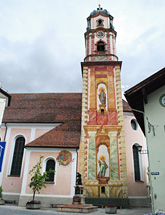 The name Mittenwald means essentially "middle of the forest", and since Roman times the spot had been the waypoint for travelers over the Alps, carrying goods over the Brenner Pass from the noble city state of Venice to the Habsburg controlled Tyrol, then to Munich. Goods carried by pack over the high pass would be offloaded at Mittenwald where the road meets the Isar, to be carried on by water raft to Munich. In the Middle Ages this trade route brought considerable wealth to the little town, under the control of the German Prince Bishops of Freising since the 14th Century until the formation of the state of Bavaria in 1803. It was this trade wealth which built the colorful half-timbered alpine houses which line the main street. The town grew wealthier around the turn of the 16th Century in the religious conflicts of the Reformation in the “eighty years war” between the Catholic Spanish Kings and the rebellious Protestant Dutch (see Count Egmont Statue), when gold shipments to pay for troops, once carried by ship but then vulnerable to English privateers, would be carted over the Alps.
The name Mittenwald means essentially "middle of the forest", and since Roman times the spot had been the waypoint for travelers over the Alps, carrying goods over the Brenner Pass from the noble city state of Venice to the Habsburg controlled Tyrol, then to Munich. Goods carried by pack over the high pass would be offloaded at Mittenwald where the road meets the Isar, to be carried on by water raft to Munich. In the Middle Ages this trade route brought considerable wealth to the little town, under the control of the German Prince Bishops of Freising since the 14th Century until the formation of the state of Bavaria in 1803. It was this trade wealth which built the colorful half-timbered alpine houses which line the main street. The town grew wealthier around the turn of the 16th Century in the religious conflicts of the Reformation in the “eighty years war” between the Catholic Spanish Kings and the rebellious Protestant Dutch (see Count Egmont Statue), when gold shipments to pay for troops, once carried by ship but then vulnerable to English privateers, would be carted over the Alps.
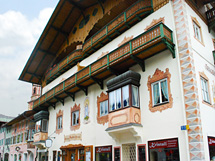 In 1684, Mittenwald gained its other claim-to-fame identity as the “Village of a Thousand Violins” when Matthias Klotz, the son of a local farmer who had left his provincial mountain home to make his way in Italy, studying under master violin maker Nicolo Amati, alongside fellow student Antonio Stradivari, returned to his home town from Cremona to set up is own shop. The Klotz handcrafted violins, cellos and violas gained in reputation and demand, so that he began to train his brothers and others from the village in the art, utilizing the ample wood supply from the surrounding forest. This heritage is memorialized by the large half-carved violin monument in the middle of town.
In 1684, Mittenwald gained its other claim-to-fame identity as the “Village of a Thousand Violins” when Matthias Klotz, the son of a local farmer who had left his provincial mountain home to make his way in Italy, studying under master violin maker Nicolo Amati, alongside fellow student Antonio Stradivari, returned to his home town from Cremona to set up is own shop. The Klotz handcrafted violins, cellos and violas gained in reputation and demand, so that he began to train his brothers and others from the village in the art, utilizing the ample wood supply from the surrounding forest. This heritage is memorialized by the large half-carved violin monument in the middle of town.
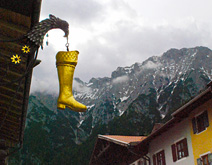 The boom of Mittenwald came to a sudden crash in the 17th Century with the building of a bridge and road over the Gotthard Pass dividing the traffic, with the town frozen in its development, leaving it as near the picture book image Goethe knew, bypassed as well by the railways over the Alps, preserving the town for tourists when touring by automobile became popular in the 1920s and 30s. In June, the annual Violin making completion will find local artisans crafting the instruments all over town, accompanied by concerts and lecture events, and a summer organ festival at the colorfully painted Baroque Church of St. Peter and Paul through September.
The boom of Mittenwald came to a sudden crash in the 17th Century with the building of a bridge and road over the Gotthard Pass dividing the traffic, with the town frozen in its development, leaving it as near the picture book image Goethe knew, bypassed as well by the railways over the Alps, preserving the town for tourists when touring by automobile became popular in the 1920s and 30s. In June, the annual Violin making completion will find local artisans crafting the instruments all over town, accompanied by concerts and lecture events, and a summer organ festival at the colorfully painted Baroque Church of St. Peter and Paul through September.
Visiting Mittenwald
Mittenwald is about an hour by car from Munich and ten minutes from Garmish-Partinkirchen, at the edge of the Wallgau Nature Park which straddles the Austrian border. With a car the village can be a base to explore the Upper Bavaria region (Oberbayern) with the Zugspitz, the castle palaces of Mad Ludwig (Schloss Linderhof and Neuschwanstein), Schloss Elmau where foreign leaders recently met are not far away. © Bargain Travel Europe
Best vacation deals compare prices in Bavaria at TripAdvisor
These articles are copyrighted and the sole property of Bargain Travel Europe and WLPV, LLC. and may not be copied or reprinted without permission.
See Also:
HOTEL LUDWIG VON BAYER - ETTAL ABBEY
SEEWIRT AT THUMSEE - SIGMUND FRUED

